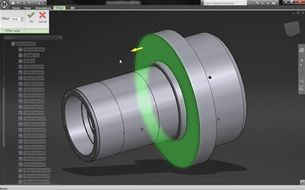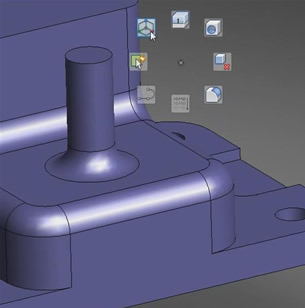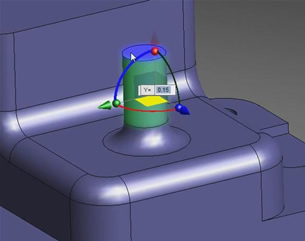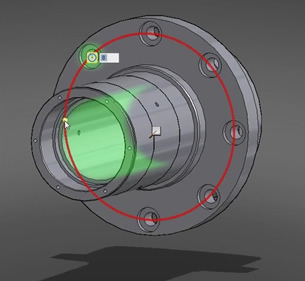Latest News
February 5, 2009
By Kenneth Wong
 Figure 1: Autodesk Inventor Fusion, currently a technology preview, is Autodesk’s response to its rival Simens PLM Software’s Synchronous Technology. |
On February 4, Autodesk joined the quest for hybrid CAD, a mechanical design program that accommodates both parametric modeling and direct modeling. As the name suggests, Autodesk Inventor Fusion is a fusion of the two, allowing you to create your geometry by whatever means you see fit (see Figure 1).
Autodesk emphatically stresses that Inventor Fusion is currently just a technology preview, not yet a product. Coming roughly 10 months after the debut of Siemens’ Synchronous Technology, Autodesk’s initiative might seem late. But the distinguishing features in Inventor Fusion suggest the technology might have what it takes to make up for lost time.
The Case for Hybrid CAD
Autodesk’s explanation of the need for a hybrid package echoes Siemens’ argument, made during the premier of Synchronous Technology in April 2008. Autodesk’ philosophy, explains Andrew Anagnost, vice president of CAD/CAE for Autodesk Manufacturing Solutions, is to provide scalable technology. As he says, “you can use that technology for something relatively straightforward and simple, but you can also use it for increasingly complicated ]projects].”
 Figure 2: In Inventor Fusion, you are periodically provided with graphical prompts that show the editing options available. |
Just as the 2D drafting tools are still in demand amidst increased adoption of 3D CAD, Anagnost predicts the need for parametric modeling will remain despite the appeal of direct modeling. Inventor Fusion, he points out, offers the best of both worlds, allowing users to build geometry through parametric inputs as well as simply push-and-pull operations.
“There are things about parametric that are good; there are things about direct modeling that are good,” acknowledges Anagnost. “Parametric gets in the way of quick design changes. If you don’t know how the model was created, you can break a model ]with your changes]. Direct editing allows you to modify models that are not native ]to your CAD system], easy to explore what-if scenarios, easy to create a concept from scratch without worrying about the parameters.”
Inventor Fusion represents, in Anagnost’s words, “a system that lets you use both the big, heavy mode, and the light, nimble mode.”
 Figure 3: Though Inventor Fusion may encourage you to create geometry through push-and-pull operations, the parametric input option remains close by. |
The Roundtrip Advantage
With Inventor Fusion technology, your modeling options often appear as a series of choices represented by graphical icons, allowing you to pick and choose the operation you want (see Figure 2). During your direct editing sessions, the input parameter box remains close by. Should you decide to make your changes in precise measurements, you can make good use of the input box (see Figure 3). For repetitive operations like patterning, the software provides a preview of the possible outcome to eliminate a fair amount of guesswork (see Figure 4).
So what distinguishes Inventor Fusion’s underlying technology from its rival Synchronous Technology, made available via Siemens’ NX and Solid Edge software? The answer is, in Anagnost’s words, “a two-way street; the ability to move back and forth seamlessly between the two modeling paradigms.”
Anagnost points out that, with Synchronous Technology, you must migrate your existing CAD parts and assemblies to the new data structure and commit to the new modeling paradigm—Solid Edge with Synchronous Technology or NX with Synchronous Technology—for future operations. By contrast, you can open a part designed parametrically in Inventor, make the desired changes using Inventor Fusion’s direct modeling mode, and then open the same part in the parametric environment in Inventor without hiccups.
 Figure 4: In pattern operations, Inventor Fusion gives you a preview of the possible outcome. |
Anagnost says, with Inventor Fusion, you can make a change using direct editing, but if you wish to parametrically refine the geometry deformation after the fact, you may go back to the feature tree to modify the parameters. He clarifies that Inventor Fusion automatically figures out the parametric modeling steps necessary to accomplish the direct edits, “including the order of dependencies.”
On the other hand, Paul Brown, Siemens PLM Software’s director of NXMarketing, points out that, “Synchronous Technology, which is implemented andavailable today inside of NX as part of our Design Freedom tool set, offers bothhistory and history-free modes of model creation. So while the user has accessto this powerful new technology, their investment in history-based designs iscompletely preserved and protected. Synchronous Technology works effectively onexisting history-based parametric models and can be used to create history-freedesigns if the user wants to follow that approach. This means that there is noneed to retrain users, and there is no learning curve to begin using SynchronousModeling.”
Dan Staples, director of Solid Edge development at Siemens,adds, “If you make a decision to move to Synchronous Technology’s way ofmodeling (in Solid Edge), you actually have no reason to revert back to thetraditional way of modeling. Synchronous Technology is a superset oftechnologies.”
Inventor Fusion will be a technology preview, available for CAD users to test drive. “But in the future—though we can’t commit to when—this will be how Inventor works,” says Anagnost.
Autodesk
San Rafael, CA
Autodesk Inventor Fusion
Siemens PLM Software
Plano, TX
“Siemens PLM’s NX6 Improved with Synchronous Technology,” January 1, 2009, DE
“Solid Edge Gains Efficiency from Synchronous Technology,” October 1, 2008, DE
Kenneth Wong writes about technology, its innovative use, and its implications. He has written for Computer Graphics World, Cadalyst, Game Developer, and Manufacturing Business Technology. You can reach him at [email protected], follow him on Twitter at KennethWongCAD, or send e-mail about this report to [email protected].
Subscribe to our FREE magazine, FREE email newsletters or both!
Latest News
About the Author
Kenneth Wong is Digital Engineering’s resident blogger and senior editor. Email him at [email protected] or share your thoughts on this article at digitaleng.news/facebook.
Follow DE





